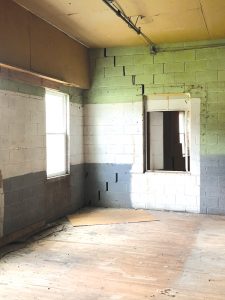A magnitude 5.1 earthquake struck near Sparta, North Carolina, on August 9, 2020, at 8:07 a.m. local time. The event was the strongest North Carolina earthquake since 1916, producing “very strong” shaking and over 100,000 Did You Feel It? reports throughout the southern, midwestern, and northeastern United States. More than 500 residential and commercial structures were damaged during the quake. As a result, North Carolina Emergency Management deployed eight post-disaster building safety evaluators, including four engineers, to evaluate the damaged structures for safe occupancy.

Unsurprisingly, the most visible damage was non-structural and included collapsed ceiling finishes, toppled chimneys, bowed or collapsed brick veneer, and displaced contents. Structural damage was generally limited to those systems known to be seismically hazardous such as plain (i.e., unreinforced) brick, concrete block, and stone masonry. While most single-family residences were wood-framed construction, their foundations were often composed of plain concrete block masonry. In general, short unreinforced masonry stem walls survived with minor cracking; however, deep crawl spaces and walkout basements suffered considerably, developing wide cracks and lateral differential displacement within the mortar joints.
In total, 17 buildings were red-tagged (i.e., deemed unsafe for re-entry), including 10 single-family dwellings, one school, and a handful of commercial and mixed-use buildings. At least 5 of these buildings were later razed as a result of the damage. Moreover, 260 additional buildings were yellow-tagged (i.e., deemed restricted use) due to the potential for falling debris and/or further displacement during aftershocks.
The construction of each of the red-tagged structures pre-dated 1978 and consisted of plain masonry foundations and/or exterior walls. North Carolina building codes of that era generally allowed unreinforced masonry in foundation walls up to 7 feet in height, as permitted by the building official.
To date, little consideration has been given to the seismic retrofit of buildings along the Eastern Seaboard, particularly residential dwellings and rural communities. This oversight is almost certainly due to the high economic investment required for such retrofits combined with a perceived immunity to seismic risk. However, the seismic risk may be higher than realized.
The eastern United States has a history of strong earthquakes. Several faults along the east coast were created 250 million years ago with the formation of the Appalachian Mountains. These faults caused the magnitude 6.7 earthquake in Charleston, South Carolina, in 1886, a magnitude 5.8 earthquake near Washington, D.C., in 2011, and a magnitude 5.2 earthquake in Buncombe County, North Carolina, in 1916.
Additionally, earthquakes on the east coast tend to affect larger areas than earthquakes of similar magnitude along the west coast. For instance, the 2011 earthquake in Washington, D.C., was felt up to 600 miles from its epicenter. In contrast, the magnitude 6.0 earthquake in Napa Valley, California, in 2014 was felt just 250 miles from its epicenter. These differences are most likely due to regional variations in the composition and geologic history of the underlying tectonic plates.
Furthermore, many of the larger earthquakes in North Carolina occurred when the state was more rural. The existence of denser population centers only magnifies the potential for damage during future events.
What can structural engineers do to promote seismic resilience in their communities? A first step might be to become familiar with and promote the use of FEMA P-154 Rapid Visual Screening of Buildings for Potential Seismic Hazards: A Handbook. The methodology described in this document enables building owners to identify whether their structures are vulnerable to earthquake damage. Once potentially vulnerable buildings are identified, the owners can prioritize future earthquake risk reduction and mitigation efforts.
Additionally, engineers may choose to volunteer their expertise in the aftermath of an earthquake by providing post-disaster building safety assessments. These assessments are vital to the expeditious re-habitation of affected but otherwise safe structures and the long-term recovery of the community at large.
To become a volunteer post-disaster building safety evaluator, contact your Structural Engineering Emergency Response (SEER) Committee Chair. A complete listing of the committee chairs can be found at www.ncsea.com/committees/seercommittee. The requirements vary by state, but, in general, qualified volunteers must complete a disaster responder training course such as the Safety Assessment Program (SAP) offered by the California Office of Emergency Services (CalOES) or the “When Disaster Strikes…” Institute offered by the International Code Council.■
